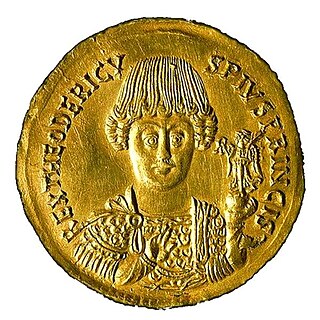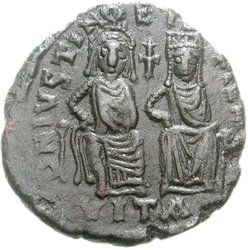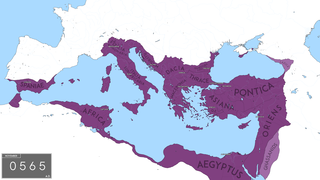
Justinian I, also known as Justinian the Great, was the Roman emperor from 527 to 565.
The 510s decade ran from January 1, 510, to December 31, 519.
The 490s decade ran from January 1, 490, to December 31, 499.

Year 518 (DXVIII) was a common year starting on Monday of the Julian calendar. At the time, it was known as the Year of the Consulship of Paulus without colleague. The denomination 518 for this year has been used since the early medieval period, when the Anno Domini calendar era became the prevalent method in Europe for naming years.

Leo I, also known as "the Thracian", was Eastern Roman emperor from 457 to 474. He was a native of Dacia Aureliana near historic Thrace. He is sometimes surnamed with the epithet "the Great", probably to distinguish him from his young grandson and co-augustus Leo II.

Zeno was Eastern Roman emperor from 474 to 475 and again from 476 to 491. His reign was plagued by domestic revolts and religious dissension, but was more successful on the foreign front. He is credited with further stabilizing the Eastern empire, while the Western Roman Empire fell following the deposition of Romulus Augustulus.

The Gothic War between the Byzantine Empire during the reign of Emperor Justinian I and the Ostrogothic Kingdom of Italy took place from 535 to 554 in the Italian Peninsula, Dalmatia, Sardinia, Sicily, and Corsica. It was one of the last of the many Gothic Wars against the Roman Empire. The war had its roots in the ambition of the Byzantine emperor Justinian I to recover the provinces of the former Western Roman Empire, which the Romans had lost to invading barbarian tribes in the previous century, during the Migration Period.

The Ostrogothic Kingdom, officially the Kingdom of Italy, was a barbarian kingdom established by the Germanic Ostrogoths that controlled Italy and neighbouring areas between 493 and 553. Led by Theodoric the Great, the Ostrogoths killed Odoacer, a Germanic soldier and erstwhile leader of the foederati. Odoacer had previously become the de facto ruler of Italy following his deposition of Romulus Augustulus, the final emperor of the Western Roman Empire, in 476. Under Theodoric, the Ostrogothic kingdom reached its zenith, stretching from modern Southern France in the west to the modern western Serbia in the southeast. Most of the social institutions of the late Western Roman Empire were preserved during his rule. Theodoric called himself Gothorum Romanorumque rex 'King of the Goths and Romans', demonstrating his desire to be a leader for both peoples.

Theodora was a Byzantine empress and wife of emperor Justinian I. She was from humble origins and became empress when her husband became emperor in 527. She was one of his chief advisers. Theodora is recognized as a saint in the Eastern Orthodox Church and the Oriental Orthodox Church, and commemorated on 14 November.

Aelia Sophia was Byzantine empress as the wife of Emperor Justin II. Although never a monarch, Sophia participated in the governance of the empire; she took an interest in economic and financial matters during Justin's reign, and subsequently served as regent during his incapacity from 573 until 578.

Euphemia, born Lupicina, was an Empress of the Eastern Roman Empire by marriage to Justin I.

The Byzantine Empire underwent a golden age under the Justinian dynasty, beginning in 518 AD with the accession of Justin I. Under the Justinian dynasty, particularly the reign of Justinian I, the empire reached its greatest territorial extent since the fall of its Western counterpart, reincorporating North Africa, southern Illyria, southern Spain, and Italy into the empire. The Justinian dynasty ended in 602 with the deposition of Maurice and the ascension of his successor, Phocas.
Vitalian was a general of the Eastern Roman Empire. A native of Moesia in the northern Balkans, and probably of mixed Roman and Gothic or Scythian barbarian descent, he followed his father into the imperial army, and by 513 had become a senior commander in Thrace.
Pompeius was a politician of the Eastern Roman Empire and nephew of the Emperor Anastasius I. His family gained political prominence with the accession of Anastasius. Pompeius was consul in 501, and was elevated to the patricianate, probably by Anastasius. He held military office, serving in the Iberian War. He married a woman named Anastasia, and had at least one son. In 532, Pompeius' brother Hypatius was acclaimed emperor by the rioters during the Nika riots; after the riots were put down, both Hypatius and Pompeius were executed.
Theocritus was a candidate to the throne of the Eastern Roman Empire in 518. He lost to Justin I.

The Samaritan revolts were a series of insurrections in Palaestina Prima province, launched by the Samaritans against the Byzantine Empire. The revolts were marked by great violence on both sides, and their brutal suppression at the hands of the Byzantines and their Ghassanid allies severely reduced the Samaritan population. The events irreversibly shifted the demographics of the region, making the Christians the only dominant group in the Palaestina Prima province for many decades onward.
Marinus was one of the most trusted and senior aides of the Eastern Roman emperor Anastasius I. He served twice as the praetorian prefect of the East, supervised some of Anastasius's tax reforms, supported the Emperor's pro-Monophysite policies and led the Roman navy in a crucial battle that ended the rebellion of general Vitalian in Thrace decisively. He survived into the regime of Justin I, when he served his second tenure as the praetorian prefect, but was soon sidelined from power and died sometime before 539 AD.
Amantius was the head chamberlain of the Byzantine emperor Anastasius I. Defeated by Justin I in the intrigues and power struggles after Anastasius' death, he was executed.

This article lists historical events that occurred between 501–600 in modern-day Lebanon or regarding its people.
Rufinus was a Byzantine military officer and emissary of the 6th century, active during the reigns of emperors Anastasius I Dicorus, Justin I, and Justinian I. Of Greek origin, he was the son and brother, respectively, of the officers Silvanus and Timostratus. He first appeared in 502, when he was sent by Anastasius to the court of the Sasanian shah Kavad I with large amounts of money to prevent attacks on the Byzantine Empire. When Rufinus learned of the Persian attacks, he left the money in Caesarea and met in Amida Kavad I, who imprisoned him until January 503, when he was released and sent to the emperor.


















